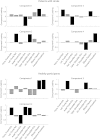Unraveling the interaction between pathological upper limb synergies and compensatory trunk movements during reach-to-grasp after stroke: a cross-sectional study
- PMID: 22791198
- PMCID: PMC3412086
- DOI: 10.1007/s00221-012-3169-6
Unraveling the interaction between pathological upper limb synergies and compensatory trunk movements during reach-to-grasp after stroke: a cross-sectional study
Abstract
The aim of the present study was to identify how pathological limb synergies between shoulder and elbow movements interact with compensatory trunk movements during a functional movement with the paretic upper limb after stroke. 3D kinematic joint and trunk angles were measured during a reach-to-grasp movement in 46 patients with stroke and 12 healthy individuals. We used principal component analyses (PCA) to identify components representing linear relations between the degrees of freedom of the upper limb and trunk across patients with stroke and healthy participants. Using multivariate logistic regression analysis, we investigated whether component scores were related to the presence or absence of basic limb synergies as indicated by the arm section of the Fugl-Meyer motor assessment (FMA). Four and three principal components were extracted in patients with stroke and healthy individuals, respectively. Visual inspection revealed that the contribution of joint and trunk angles to each component differed substantially between groups. The presence of the flexion synergy (Shoulder Abduction and Elbow Flexion) was reflected by component 1, whereas the compensatory role of trunk movements for lack of shoulder and elbow movements was reflected by components 2 and 3 respectively. The presence or absence of basic limb synergies as determined by means of the FMA was significantly related to components 2 (p = 0.014) and 3 (p = 0.003) in patients with stroke. These significant relations indicate that PCA is a useful tool to identify clinically meaningful interactions between compensatory trunk movements and pathological synergies in the elbow and shoulder during reach-to-grasp after stroke.
Figures




Similar articles
-
Superposition of independent units of coordination during pointing movements involving the trunk with and without visual feedback.Exp Brain Res. 2000 Apr;131(3):336-49. doi: 10.1007/s002219900267. Exp Brain Res. 2000. PMID: 10789948
-
Arm-trunk coordination for beyond-the-reach movements in adults with stroke.Neurorehabil Neural Repair. 2014 May;28(4):355-66. doi: 10.1177/1545968313510973. Epub 2013 Nov 22. Neurorehabil Neural Repair. 2014. PMID: 24270057
-
Characterization of stroke-related upper limb motor impairments across various upper limb activities by use of kinematic core set measures.J Neuroeng Rehabil. 2022 Jan 12;19(1):2. doi: 10.1186/s12984-021-00979-0. J Neuroeng Rehabil. 2022. PMID: 35016694 Free PMC article.
-
Getting a kinematic handle on reach-to-grasp: a meta-analysis.Physiotherapy. 2018 Jun;104(2):153-166. doi: 10.1016/j.physio.2017.10.002. Epub 2017 Nov 11. Physiotherapy. 2018. PMID: 29402446 Review.
-
Upper limb kinematics after cervical spinal cord injury: a review.J Neuroeng Rehabil. 2015 Jan 30;12:9. doi: 10.1186/1743-0003-12-9. J Neuroeng Rehabil. 2015. PMID: 25637224 Free PMC article. Review.
Cited by
-
Influence of the Passive Stabilization of the Trunk and Upper Limb on Selected Parameters of the Hand Motor Coordination, Grip Strength and Muscle Tension, in Post-Stroke Patients.J Clin Med. 2021 May 29;10(11):2402. doi: 10.3390/jcm10112402. J Clin Med. 2021. PMID: 34072303 Free PMC article.
-
Robotic exoskeletons: a perspective for the rehabilitation of arm coordination in stroke patients.Front Hum Neurosci. 2014 Dec 1;8:947. doi: 10.3389/fnhum.2014.00947. eCollection 2014. Front Hum Neurosci. 2014. PMID: 25520638 Free PMC article. Review.
-
Development of a compensation-aware virtual rehabilitation system for upper extremity rehabilitation in community-dwelling older adults with stroke.J Neuroeng Rehabil. 2023 May 1;20(1):56. doi: 10.1186/s12984-023-01183-y. J Neuroeng Rehabil. 2023. PMID: 37127574 Free PMC article.
-
Post-stroke kinematic analysis in rats reveals similar reaching abnormalities as humans.Sci Rep. 2018 Jun 7;8(1):8738. doi: 10.1038/s41598-018-27101-0. Sci Rep. 2018. PMID: 29880827 Free PMC article.
-
Is two better than one? Muscle vibration plus robotic rehabilitation to improve upper limb spasticity and function: A pilot randomized controlled trial.PLoS One. 2017 Oct 3;12(10):e0185936. doi: 10.1371/journal.pone.0185936. eCollection 2017. PLoS One. 2017. PMID: 28973024 Free PMC article. Clinical Trial.
References
-
- Aymard C, Katz R, Lafitte C, Lo E, Penicaud A, Pradat-Diehl P, Raoul S. Presynaptic inhibition and homosynaptic depression: a comparison between lower and upper limbs in normal human subjects and patients with hemiplegia. Brain. 2000;123(Pt 8):1688–1702. doi: 10.1093/brain/123.8.1688. - DOI - PubMed
-
- Bernstein N. The co-ordination and regulation of movements. New York: Pergamon Press; 1967.
-
- Brunnstrom S (1970) Movement therapy in hemiplegia: a neurophysiological approach. Medical Dept, Harper & Row, New York
Publication types
MeSH terms
Grants and funding
LinkOut - more resources
Full Text Sources
Medical

